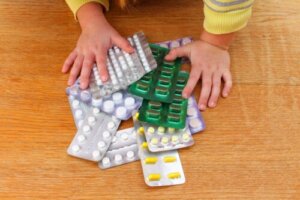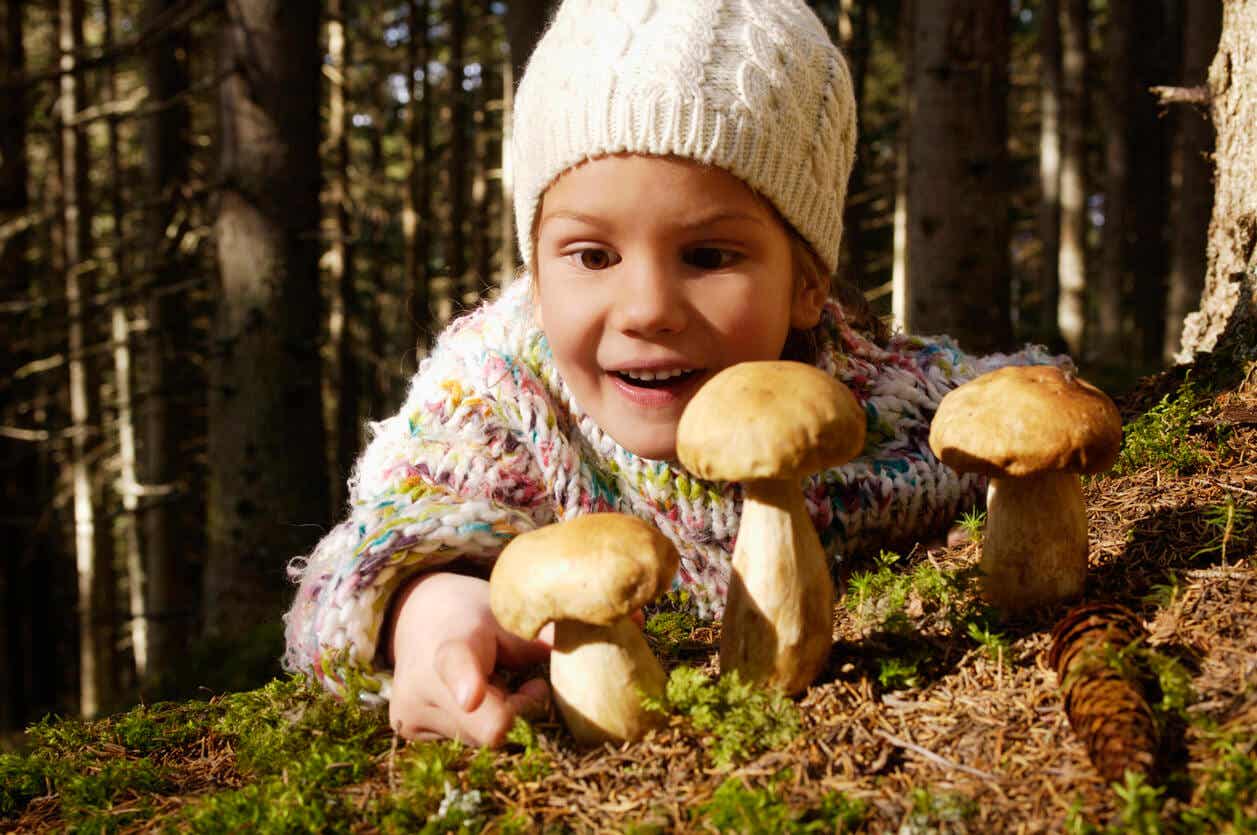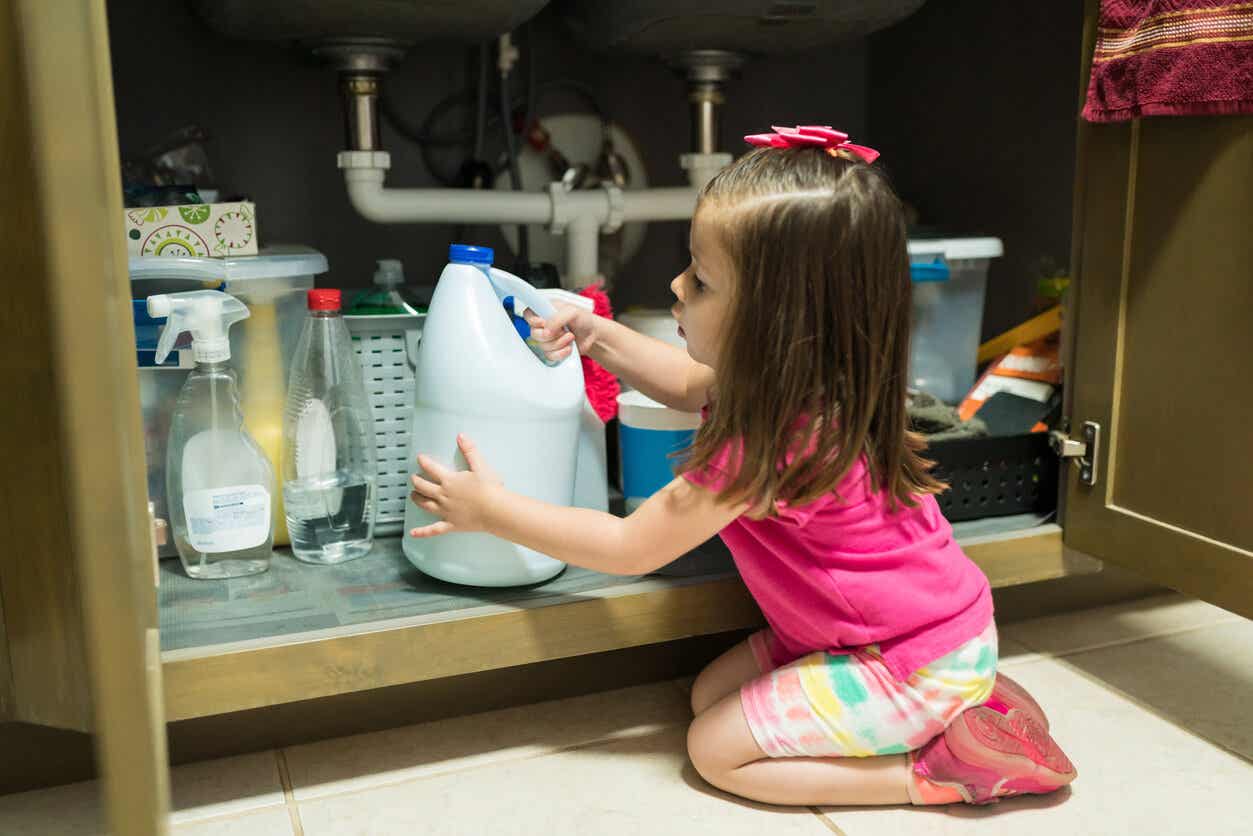How to Act in Case of Poisoning in Children?


Written and verified by the pediatrician Marcela Alejandra Caffulli
Poisoning in children is one of the main external injuries that occur among the pediatric age group.
Currently, in Spain, 1 out of every 250-300 consultations in pediatric emergency departments are due to exposure to a potentially toxic substance. And up to 20% of these patients require hospitalization because they need further medical care (Mintegui 2019).
While many times, the exposure is avoidable, other times, it’s not. For this reason, it’s important for parents to know how poisoning manifests itself and how to act when they detect it, as time in these cases is a determining factor.
What are we referring to when we talk about poisoning in children?
When we talk about poisoning or intoxication, we’re referring to the damage that occurs after direct contact with a potentially toxic substance.
This can occur under different circumstances (intentionally or unintentionally) and through different routes of entry into the body (orally, by inhalation, through contact with the skin, among others).
At the same time, it can occur suddenly and in a short period of time (acute) or be the consequence of prolonged and sustained exposure over time (chronic).
In the pediatric age group, most cases of poisoning are acute and occur via the digestive tract (Curi, 2020).
How does poisoning in children occur?

Contact with toxins has particular characteristics depending on the age of the child. In poisoning in children, there are two main age groups:
Children from 0 to 5 years old
This is the largest group, and its main characteristics are as follows:
- Poisonings are usually non-voluntary (Currently, we know these as Non-Intentional External Cause Injuries and are what we used to refer to as accidents).
- They take place in the context of an age-typical exploratory behavior.
- They occur at home.
- Poisonings are more frequent in males.
- The toxic substances are usually known (they’re usually cleaning products).
- Visits to the emergency department are usually immediate and the child usually arrives there without symptoms.
- They have a good prognosis.
Older children and adolescents
- Poisonings are usually intentional, often for play or recreational purposes.
- They occur outside the home.
- They occur mainly in women.
- The toxins aren’t always known.
- Visits to the emergency department take place later on and patients arrive with more symptoms.
- Management is more complex and the prognosis is less favorable.
There’s a separate group, which is smaller in number but of great importance, which consists of Intentional External Cause Injuries with homicidal purposes or those that occur in the context of either abuse or neglect. (Minitegui, 2019)
The most frequent toxics
1. Medications
Since the last decade, medications have been the cause of 50% of poisoning cases in children, despite the creation of safety caps and other preventive mechanisms.
Tylenol (paracetamol) ranks first, followed by psychotropic drugs and cough syrups.
2. Household products

Household products are the second most important cause of intoxication in pediatrics However, they’re the main cause when it comes to children under the age of 2.
It usually occurs at home, mainly in the kitchen, due to easy access to the place where these products are stored.
The most common products are detergents, bleaches, and insecticides. Due to their bad smell and taste, children usually only ingest small amounts. However, due to the nature of the substances they contain, the consequences could still be serious.
3. Alcohol
The ingestion of alcohol is the main cause of consultation in pediatric emergency departments in Spain.
Sadly, the number of cases is increasing and the age of the patients is getting younger. Consumption is usually related to recreational purposes and often, this intake involves other drugs as well, such as cannabis.
4. Carbon monoxide
Carbon monoxide is a toxic, odorless, and colorless gas that any device used to burn fuel can produce:
- Boilers, water heaters, stoves, fireplaces, or gas radiators that don’t work properly and ventilation is insufficient
- Fireplaces with wood or woodburning stoves
- Smoke from fires
- Smoke from automobile exhaust
- Tobacco smoke
It’s a significant cause of intoxication in the winter season and usually affects several members of the family at the same time. In Spain, it makes up about 5% of the consultations to pediatric emergency services.
What are the symptoms of poisoning in children?
Usually, the symptoms of poisoning are non-specific.
Adults usually begin to suspect it when there are sudden changes in the general condition of a previously healthy child, without any other apparent cause.
Some suggestive signs are:
- Atypical behavior
- Gait disturbances or loss of balance
- Seizures
- Agitation or difficulty breathing
- Nausea and vomiting
- Blurred vision
- Palpitations
- Small pupils
- A peculiar odor on the skin or breath
- Burns on the mouth, skin, or mucous membranes
What should I do if I suspect that poisoning has occurred?
First of all, when we suspect that a child has ingested or been exposed to some sort of poison, it’s important to stay calm. The time that elapses is decisive, so we must seek professional advice immediately.
To do so, it’s best to contact the local Poison Control Center by phone. Usually, you can find the number on the label of chemical products and medicines. These centers operate 24 hours a day, 7 days a week.
During the phone call, you’ll be asked for information about the poison ingested, the amount, the time, the symptoms your child presents, whether or not anyone else in the home was affected, and some previous history.
It’s important to have these data on hand, along with the child’s approximate weight.
As long as the child’s general condition is good, the following general measures should be taken at home to remove the poison:
- Remove any tablet from the child’s mouth, making them spit it out, or else by using your fingers if you can visualize it.
- Remove the child from the room, in case of suspected inhalation poisoning.
- If the exposure was through the skin, remove the child’s clothes and wash their skin with warm water and soap, without rubbing.
- In the case that the poisoning entered through the eyes, you should wash with plenty of warm water or physiological solution for 15-20 minutes.
- If the child has ingested a liquid substance (non-drug), offer a glass of water or milk.
Experts don’t recommend that you induce vomiting at home.
When to go to a health center?
If the child shows serious symptoms, such as impaired consciousness (e.g. fainting), difficulty breathing, or if you can’t feel their pulse, you should take them to the nearest emergency room immediately.
On the other hand, if the general condition of the child is good, it’s best to consult a health center when the child has ingested any of the following products:
- Toilet cleaning products, sink uncloggers, bleaches, ammonia
- Petroleum products: Kerosene, gasoline, grease solvent (turpentine), furniture polish, lighter fluid
- Drugs, plants, and other household chemicals (such as cosmetics or personal care products)
About poisoning in children…
Poisonings are very frequent among the pediatric age group and you need to know in advance what to do when they occur. That way, many times, you’ll be able to prevent serious injuries. Even so, the most important thing is to take all the preventive measures you can at home.
Poisoning in children is one of the main external injuries that occur among the pediatric age group.
Currently, in Spain, 1 out of every 250-300 consultations in pediatric emergency departments are due to exposure to a potentially toxic substance. And up to 20% of these patients require hospitalization because they need further medical care (Mintegui 2019).
While many times, the exposure is avoidable, other times, it’s not. For this reason, it’s important for parents to know how poisoning manifests itself and how to act when they detect it, as time in these cases is a determining factor.
What are we referring to when we talk about poisoning in children?
When we talk about poisoning or intoxication, we’re referring to the damage that occurs after direct contact with a potentially toxic substance.
This can occur under different circumstances (intentionally or unintentionally) and through different routes of entry into the body (orally, by inhalation, through contact with the skin, among others).
At the same time, it can occur suddenly and in a short period of time (acute) or be the consequence of prolonged and sustained exposure over time (chronic).
In the pediatric age group, most cases of poisoning are acute and occur via the digestive tract (Curi, 2020).
How does poisoning in children occur?

Contact with toxins has particular characteristics depending on the age of the child. In poisoning in children, there are two main age groups:
Children from 0 to 5 years old
This is the largest group, and its main characteristics are as follows:
- Poisonings are usually non-voluntary (Currently, we know these as Non-Intentional External Cause Injuries and are what we used to refer to as accidents).
- They take place in the context of an age-typical exploratory behavior.
- They occur at home.
- Poisonings are more frequent in males.
- The toxic substances are usually known (they’re usually cleaning products).
- Visits to the emergency department are usually immediate and the child usually arrives there without symptoms.
- They have a good prognosis.
Older children and adolescents
- Poisonings are usually intentional, often for play or recreational purposes.
- They occur outside the home.
- They occur mainly in women.
- The toxins aren’t always known.
- Visits to the emergency department take place later on and patients arrive with more symptoms.
- Management is more complex and the prognosis is less favorable.
There’s a separate group, which is smaller in number but of great importance, which consists of Intentional External Cause Injuries with homicidal purposes or those that occur in the context of either abuse or neglect. (Minitegui, 2019)
The most frequent toxics
1. Medications
Since the last decade, medications have been the cause of 50% of poisoning cases in children, despite the creation of safety caps and other preventive mechanisms.
Tylenol (paracetamol) ranks first, followed by psychotropic drugs and cough syrups.
2. Household products

Household products are the second most important cause of intoxication in pediatrics However, they’re the main cause when it comes to children under the age of 2.
It usually occurs at home, mainly in the kitchen, due to easy access to the place where these products are stored.
The most common products are detergents, bleaches, and insecticides. Due to their bad smell and taste, children usually only ingest small amounts. However, due to the nature of the substances they contain, the consequences could still be serious.
3. Alcohol
The ingestion of alcohol is the main cause of consultation in pediatric emergency departments in Spain.
Sadly, the number of cases is increasing and the age of the patients is getting younger. Consumption is usually related to recreational purposes and often, this intake involves other drugs as well, such as cannabis.
4. Carbon monoxide
Carbon monoxide is a toxic, odorless, and colorless gas that any device used to burn fuel can produce:
- Boilers, water heaters, stoves, fireplaces, or gas radiators that don’t work properly and ventilation is insufficient
- Fireplaces with wood or woodburning stoves
- Smoke from fires
- Smoke from automobile exhaust
- Tobacco smoke
It’s a significant cause of intoxication in the winter season and usually affects several members of the family at the same time. In Spain, it makes up about 5% of the consultations to pediatric emergency services.
What are the symptoms of poisoning in children?
Usually, the symptoms of poisoning are non-specific.
Adults usually begin to suspect it when there are sudden changes in the general condition of a previously healthy child, without any other apparent cause.
Some suggestive signs are:
- Atypical behavior
- Gait disturbances or loss of balance
- Seizures
- Agitation or difficulty breathing
- Nausea and vomiting
- Blurred vision
- Palpitations
- Small pupils
- A peculiar odor on the skin or breath
- Burns on the mouth, skin, or mucous membranes
What should I do if I suspect that poisoning has occurred?
First of all, when we suspect that a child has ingested or been exposed to some sort of poison, it’s important to stay calm. The time that elapses is decisive, so we must seek professional advice immediately.
To do so, it’s best to contact the local Poison Control Center by phone. Usually, you can find the number on the label of chemical products and medicines. These centers operate 24 hours a day, 7 days a week.
During the phone call, you’ll be asked for information about the poison ingested, the amount, the time, the symptoms your child presents, whether or not anyone else in the home was affected, and some previous history.
It’s important to have these data on hand, along with the child’s approximate weight.
As long as the child’s general condition is good, the following general measures should be taken at home to remove the poison:
- Remove any tablet from the child’s mouth, making them spit it out, or else by using your fingers if you can visualize it.
- Remove the child from the room, in case of suspected inhalation poisoning.
- If the exposure was through the skin, remove the child’s clothes and wash their skin with warm water and soap, without rubbing.
- In the case that the poisoning entered through the eyes, you should wash with plenty of warm water or physiological solution for 15-20 minutes.
- If the child has ingested a liquid substance (non-drug), offer a glass of water or milk.
Experts don’t recommend that you induce vomiting at home.
When to go to a health center?
If the child shows serious symptoms, such as impaired consciousness (e.g. fainting), difficulty breathing, or if you can’t feel their pulse, you should take them to the nearest emergency room immediately.
On the other hand, if the general condition of the child is good, it’s best to consult a health center when the child has ingested any of the following products:
- Toilet cleaning products, sink uncloggers, bleaches, ammonia
- Petroleum products: Kerosene, gasoline, grease solvent (turpentine), furniture polish, lighter fluid
- Drugs, plants, and other household chemicals (such as cosmetics or personal care products)
About poisoning in children…
Poisonings are very frequent among the pediatric age group and you need to know in advance what to do when they occur. That way, many times, you’ll be able to prevent serious injuries. Even so, the most important thing is to take all the preventive measures you can at home.
All cited sources were thoroughly reviewed by our team to ensure their quality, reliability, currency, and validity. The bibliography of this article was considered reliable and of academic or scientific accuracy.
- Mintegi S. Grupo de Trabajo de Intoxicaciones de la Sociedad Española de Urgencias de Pediatría. Manual de Intoxicaciones de Pediatría. 3ª edición. Madrid. Ergon. 2012.
- Minitegi S, Sanchez L. Intoxicaciones. Capítulo 25. En: Sociedad Española de Urgencias de Pediatría (SEUP). Protocolos diagnósticos y terapéuticos en Urgencias de Pediatría. 3ª Edición. Madrid. 2019
- American Academy Of Pediatrics. Guía de primeros auxilios para padres y encargados del cuidado de los niños. Año 2011, última actualización año 2017. Disponible en: https://www.healthychildren.org/Spanish/safety-prevention/at-home/Paginas/first-aid-guide.aspx (Downloaded Jun 2021)
- Salazar Merino J, Minitegi S. Intoxicaciones por productos del hogar. En Familia, Asociación Española de Pediatría. Año 2014, última actualización año 2019. Disponible en https://enfamilia.aeped.es/prevencion/intoxicaciones-por-productos-hogar (Downloaded Jun 2021)
- Curi C. Manejo Inicial del Paciente Intoxicado. Capítulo 43.En: Comité Nacional de Emergencias y Cuidados Críticos en Pediatría, Sociedad Argentina de Pediatría. Manual de Emergencias y Cuidados Críticos en Pediatría. 3° Edición. Buenos Aires. Ideográfica. Año 2020
- Ministerio de Sanidad Consumo y Bienestar Social. Gobierno de España. Edición electrónica de la CIE-10-ES. 3ª Edición-Enero 2020. Disponible en: https://eciemaps.mscbs.gob.es/ecieMaps/browser/index_10_2008.html#search=&index=ext&searchId=1623007917701&historyIndex=5 (Downloaded Jun 2021)
This text is provided for informational purposes only and does not replace consultation with a professional. If in doubt, consult your specialist.








